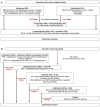Inflammatory Bowel Disease in Childhood and Adolescence
- PMID: 28597827
- PMCID: PMC5470346
- DOI: 10.3238/arztebl.2017.0331
Inflammatory Bowel Disease in Childhood and Adolescence
Abstract
Background: The incidence of inflammatory bowel disease (IBD) in childhood and adolescence is 5-11 cases per 100 000 persons per year, corresponding to a new diagnosis of IBD in 800-1470 patients in Germany each year.
Methods: This review is based on pertinent publications retrieved by a selective search in PubMed, including guidelines from Germany and abroad.
Results: Children and adolescents with IBD often have extensive involvement and an aggressive course of disease. Nonetheless, infliximab and adalimumab are the only biological agents that have been approved for this group of patients. In Crohn's disease, exclusive enteral nutrition is the treatment of first choice for inducing a remission. Patients with (peri-)anal fistulae are treated primarily with infliximab. Corticosteroids and aminosalicylates should be used with caution. In contrast, children and adolescents with ulcerative colitis are treated with either aminosalicylates or prednisolone to induce a remission. As a rule, maintenance pharmacotherapy with thiopurines in Crohn's disease and severe ulcerative colitis, or with aminosalicylates in mild to moderate ulcerative colitis, is indicated for several years, at least until the end of puberty. Patients with refractory disease courses are treated with methylprednisolone, anti-TNF-α-antibodies, and/or calcineurin inhibitors. The spectrum of surgical interventions is the same as for adults. Specific aspects of the treatment of children and adolescents with IBD include adverse drug effects, the areas of nutrition, growth, and development, and the structured transition to adult medicine.
Conclusion: Children and adolescents with IBD or suspected IBD should be cared for by pediatric gastroenterologists in a center where such care is provided. Individualized treatment with multidisciplinary, family-oriented longterm care is particularly important. Drug trials in children and adolescents are needed so that the off-label use of drugs to patients in this age group can be reduced.
Figures


References
-
- Preiß JC, Bokemeyer B, Buhr HJ, et al. [Updated German clinical practice guideline on “diagnosis and treatment of Crohn‘s disease” 2014] Z Gastroenterol. 2014;52:1431–1484. - PubMed
-
- Dignass A, Preiß JC, Aust DE, et al. [Updated German guideline on diagnosis and treatment of ulcerative colitis, 2011] Z Gastroenterol. 2011;49:1276–1341. - PubMed
-
- Benchimol EI, Fortinsky KJ, Gozdyra P, van den Heuvel M, van Limbergen J, Griffiths AM. Epidemiology of pediatric inflammatory bowel disease: a systematic review of international trends. Inflamm Bowel Dis. 2011;17:423–439. - PubMed
-
- Jakobsen C, Bartek J Jr., Wewer V, et al. Differences in phenotype and disease course in adult and paediatric inflammatory bowel disease—a population-based study. Aliment Pharmacol Ther. 2011;34:1217–1224. - PubMed
Publication types
MeSH terms
Substances
LinkOut - more resources
Full Text Sources
Other Literature Sources
Research Materials

